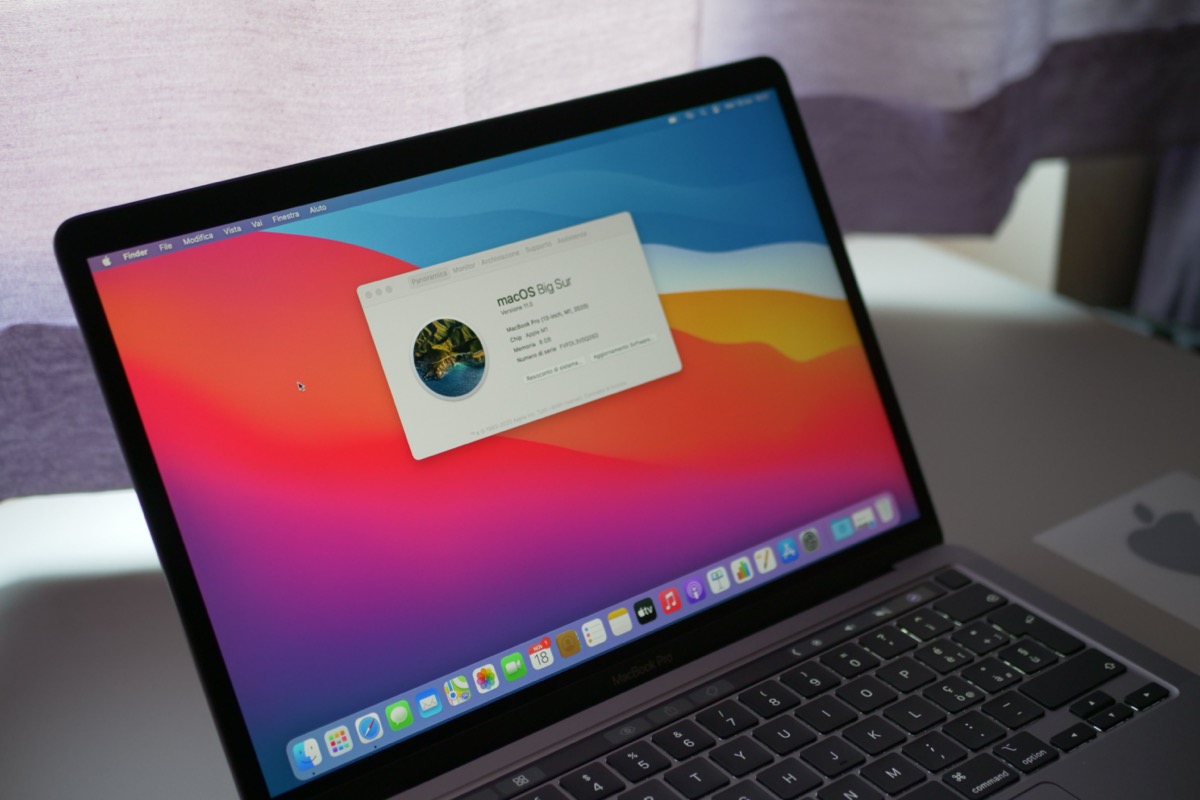It is the laptop that Apple should have made a long time ago. There is nothing wrong, and the prolonged use of the new MacBook Pro 13 M1 for a few weeks, in a certainly “closed” environment (given that due to the pandemic you cannot travel) but realistic in use, makes you understand many of those that its peculiarities, its strengths and its “normal” points (we don't feel we can talk about weaknesses) since in the end it is always a normal artifact. Although – and we tell you without exaggeration and aware that we have never written such a thing before – this MacBook Pro 13 M1 seems to be from the future, that is.
Here is the new / old MacBook Pro 13
As for the box, packaging, physical shape of the body and all the other features of the MacBook Pro 13 with M1 processor there is nothing to say. It is identical to the previous generation with Intel processor. The purpose of this computer is not to discover news on how the keyboard works, on how the screen looks or on the quality of the materials and assembly (excellent).
There is therefore no unboxing to do, except to note a fact: this computer has the exact same characteristics as the traditional two-port MacBook Pro 13. Hence, it only has two USB C ports – Thunderbolt 3 on the left side while on the right there is only the audio mini-jack. Instead, “below”, the two long side slits for cooling and air circulation are missing, just like for the twin brother Intel. The body, the keyboard, the monitor, the I / O ports are all the same. And they are excellent, with the addition that the M1 processor enhances the resolution of the camera thanks to a more sophisticated algorithm (and in video conferences we are at the level of iPad Pro). But that's the only thing. The test is therefore only on the “engine”, that is the novelty of the M1 chip in everyday life.
The benchmarks are all excellent
We have verified, but we don't want to bore you with this as it was not the goal of the test, that the “cold” and “hot” benchmarks of the MacBook Pro 13 are great, just as those of the Mac mini we reviewed here are doing well. and the MacBook Air. The main difference between the MacBook Pro 13 and the Air is verified and proven, that is the presence of an active dissipation system in the first that allows for peak performance in a more sustained way thanks to the fans. Which, however, you will never hear in normal use or even in “more than normal” use, that is, when you press the accelerator. But let's see it in a moment.
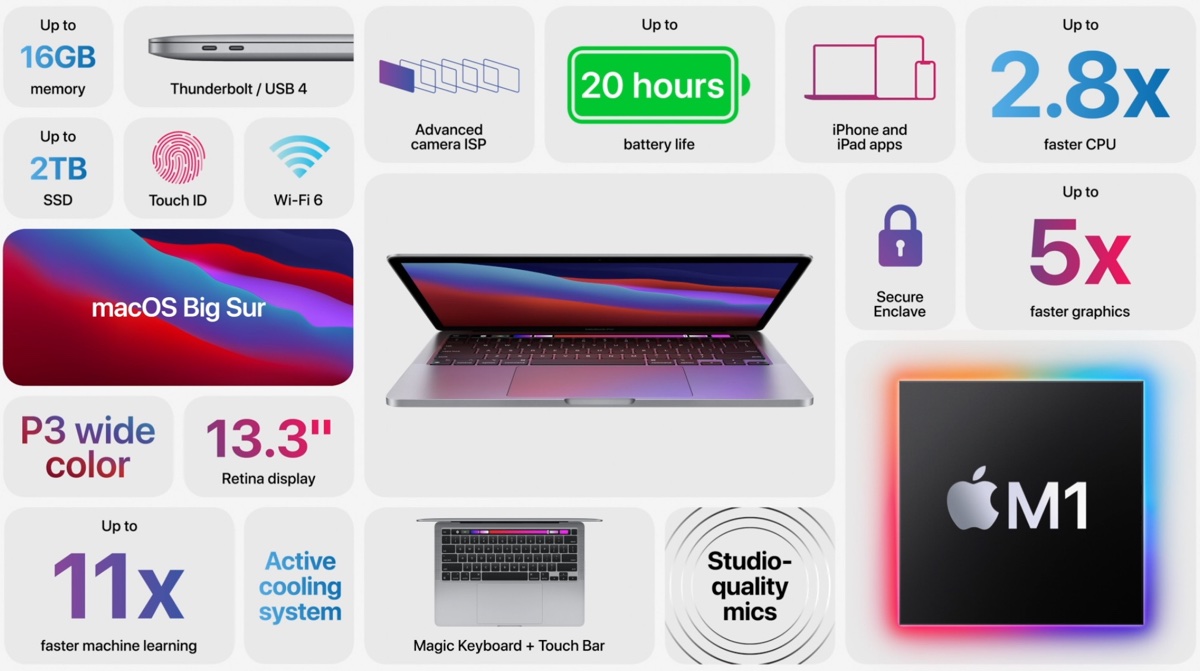
Rosetta 2 works wonders
If there's one thing that really stands out about the new Mac, it's what's inside Activity Monitor, the system app that lets you see what's running and how on your Mac. It also lets you see how many “Intel” and how many “Apple” processes (ie native to Apple Silicon) are active. That's impressive because four-fifths of the processes are all Apple. And be careful, we are not talking about single apps, but about everything that runs. This gives an idea of the level of optimization and evolution we have already reached.
But is there a performance hang with the use of software under Rosetta 2, the software layer that allows for the transcoding and execution of Intel architecture software? The answer is simple: no. We played (Tomb Raider and others), worked, used service apps (Dropbox), even our entire Homebrew installation to carry out the command line work on the Mac. To do this we selected the information on the Terminal app (and then on iTerm 2) and selected the operation with Intel architecture instead of the native Apple Silicon one. This automatically allows Terminal to install the Intel version of Homebrew and then to go and run the code of the binary apps (and compile those of which the source arrives) via Rosetta 2. Excellent.
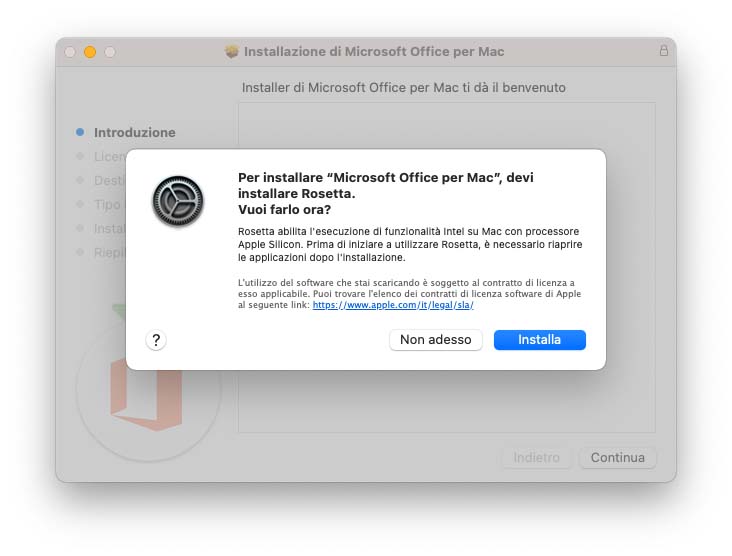 Example of message that appears at the first start of software created for Mac with Intel CPU
Example of message that appears at the first start of software created for Mac with Intel CPU
What to say? Everything works, nothing crashes and the risk of “slipping” through the field test without realizing obstacles and roughness is almost embarrassing, simply because there are none. But it is not magic: the 8 Giga of RAM runs out and there are some software that are bad citizens of the Mac environment, starting with Dropbox, a once excellent service that has now mounted its head and tries to do its comfortable activities. inside the Mac (a lot of unjustified and unjustifiable processes that run consuming computer resources) and cannot be limited but only shut down.
There is also Chrome, the Google browser, which has become a bad citizen on a par with Adobe and Microsoft and which, as far as the writer is concerned, no longer enters his Mac: there are also those who explain how to eradicate it because slips active software into the “belly” of the Mac and cannot be removed, and it slows down as well as probably “spying” the Mac.
The apps for iOS / iPadOS are still behind
We obviously experimented with the possibility of using apps developed directly for iOS and iPadOS, which can be tested on Mac without problems. In recent days, Apple has removed this possibility, which in these hours has returned but it is not known how long it will remain available. Here, however, there are roughness, above all for three reasons. The first is that many developers have voluntarily blocked the availability of their Apple Silicon app on Mac. It is an explicit option that developers when submitting apps to the Apple App Store.
The second is that many available apps are “abandoned” or in any case not updated for a while by the developers: the option of choice has not been selected and by default they are available but with the warning that they may not work. Many don't work: they crash, they can't work inside the macOS environment. Fortunately, this happens without any kind of problem for the macOS environment, which goes on quietly without pleating.
The third is that even apps approved by developers for now tend to be unsuitable for Mac operation. They are in fact designed for other types of interfaces. Over time, apps with two parallel interfaces should arrive: one on iOS / iPadOS and one on macOS. For now we have not seen any, although some more “structured” games work well, such as: Bastion, Eloh, Mini Metro, Old Man, Transistor and various others.
This obviously has nothing to do with the MacBook Pro 13 M1, and it gives us to think about since software and hardware now move together. The feeling is that Apple has done an incredible job between processor, hardware and operating system (on the latter we will arrive in a moment) up to the store, and now it is the developers who must move and not sit on their laurels. To have a perfectly integrated platform up to third-party software, even the highest level of abstraction is required, i.e. the software present on the AppStore / MacAppStore (they should also unify the name at this point).
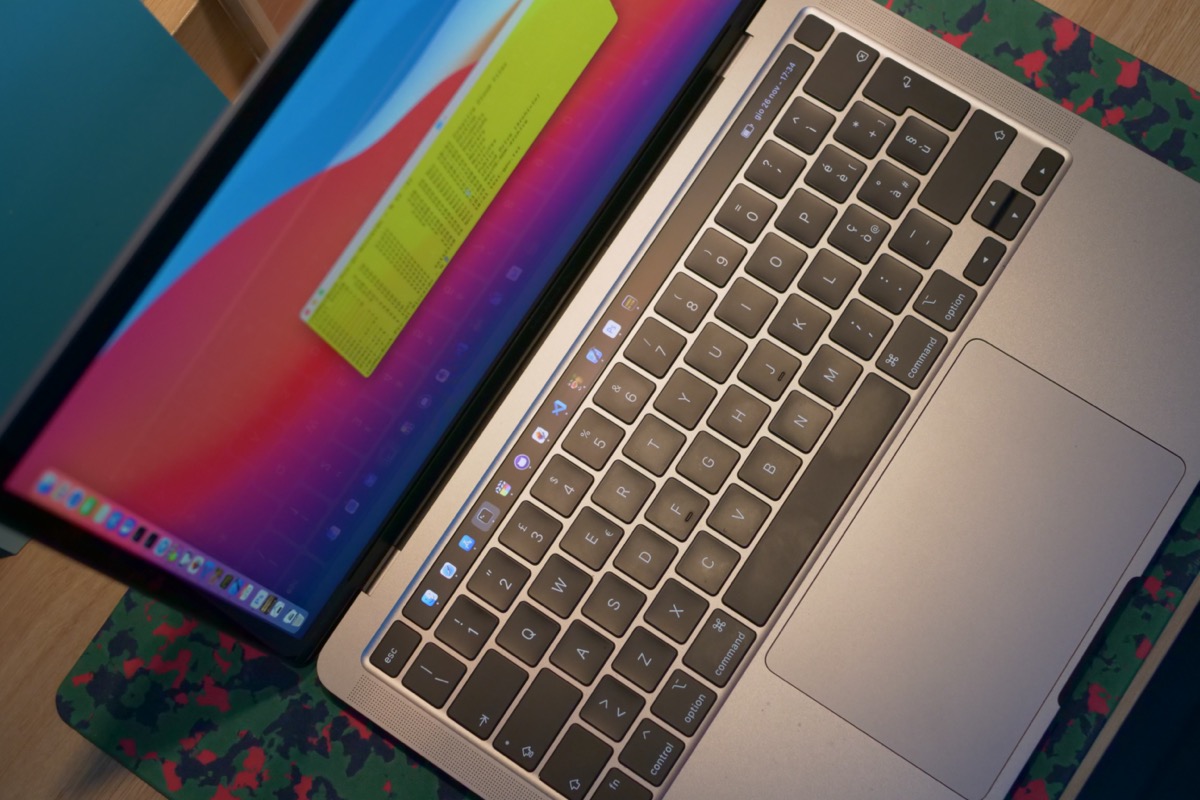
Big Sur as you've never seen it
The writer has been using his MacBook Pro 16 for a year with no problems and no regrets: the greatest convenience (especially now that you are not traveling) is the larger screen. But the writer has not been a Big Sur fan so far. Of course, an excellent operating system, but not particularly “light” from the point of view of the resources used and with an interface that is not particularly pleasant. Here, using the MacBook Pro 13 the miracle happens and Big Sur becomes an extraordinary interface: fast, effective, delicious. Everything moves as it should, there is not a single context jump that doesn't work, windows open at the right speed, ditto for apps and everything else that is part of the life of an interface. It seems evident that Big Sur was designed for the performance of M1 processors.
Here two things must be said. The first is that, like the iPad, the Mac interface now runs at the right speed, with no slowdowns or hesitation. This is important to underline because the whole Mac environment has always been strongly controlled: the interface speed is not an “absolute” speed but a “right” speed. M1 does just that, brings the execution speed to its intended speed and does it consistently and consistently across all contexts.
The second thing is that the change from other Macs with Intel (and BigSur, of course) is sharp at first, but then as with all things that work well, it is no longer noticeable. It is almost taken for granted, until you return (alas) the MacBook Pro 13 M1 under test and go back to your MacBook Pro 16 i9. A master computer, practically perfect in many ways, but definitely discontinuous – like all Macs with Intel – with respect to the performance of the Finder and the operating system interface.
Here, with M1, you have the clear feeling that no matter how much the computer is “loaded”, how many processes are running, how many windows are open, how many apps are running: everything travels at the same, constant, perfect speed as ever. And it's a lust, let me tell you. It's the Mac's way of how it's thought it should be, not the hyper-excited speed of Windows that then stumbles and crashes. Or the hesitation of Intel Macs. This simply goes away like a billiard ball, with almost no friction.
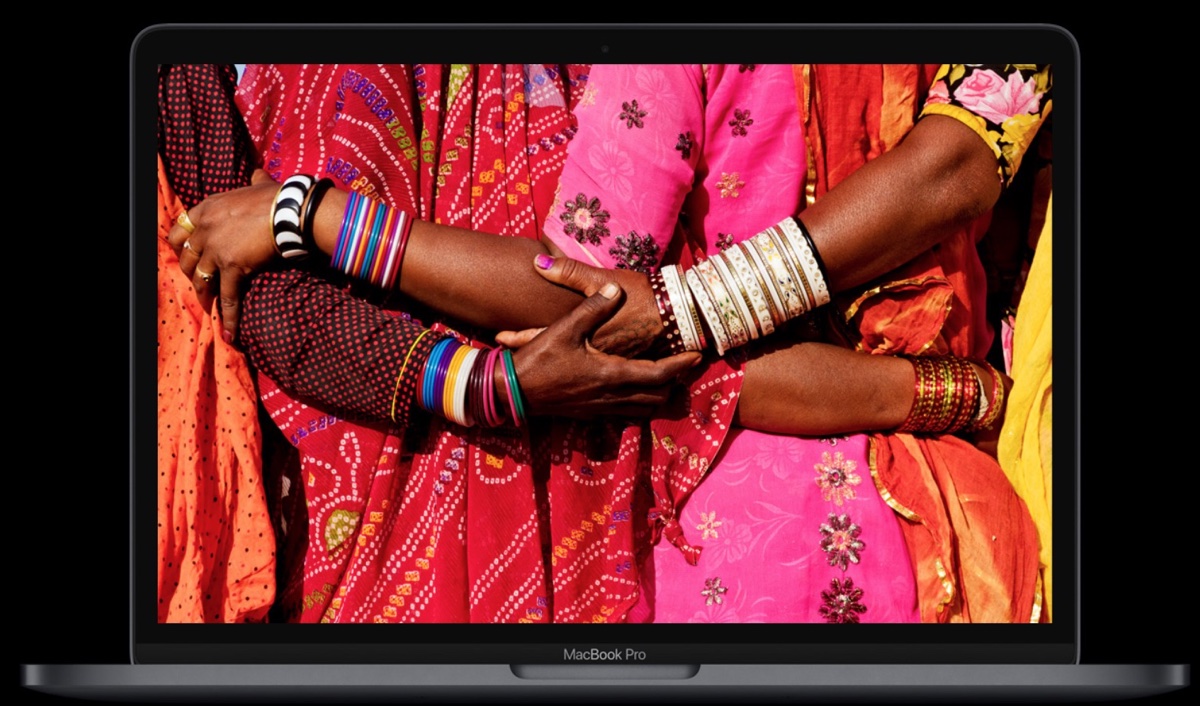
Final remarks
We hadn't seen a MacBook Pro 13 like this one, and we've basically seen and tried them all over the past twenty years. The striking thing is the power, the fluidity and the autonomy. We have just said about fluidity. Perhaps we have not said enough about power: we add here a consideration. We have not deliberately made benchmarks also because the network is literally full of them, and then because they do not return a real measure for those who make different uses: the benchmarks are theoretical references. The computer, however, is obviously powerful, and never hesitates. It's the kind of power of an iPad Pro – no matter how hard you charge it, you feel like it does everything and there's room to do even more.
The power of the M1 on this MacBook Pro 13 is, on the face of it, the power of a video game console, for which all games work well (or should, unless programmers messed around) because it's literally a reference hardware. Here, the M1 processor is a reference hardware and the equipment of the MacBook Pro 13 M1 is such as to suggest that it is currently the most powerful choice for those who want a portable Mac. Soon it probably won't be because mid-to-high-end MacBooks (and Macs) are on the way. In fact, let's not forget that the “two-door” version is the entry level of the MacBook Pro 13, and that M1 is paired with the MacBook Air and with the entry level Mac mini.
The third factor, the battery. We were hardly talking about it because we almost forgot about it. This is in fact a crazy computer for the battery. The ten, twelve hours of work are done quietly, which means more reasonably that you work for two days without having to load it. We have done various experiments while being confined in the house: hide the charger to see how far the computer is going. Well, it doesn't end anymore. You play and work quietly. Charging is also very fast and no longer binds to an optimized support point to keep the computer connected for hours.
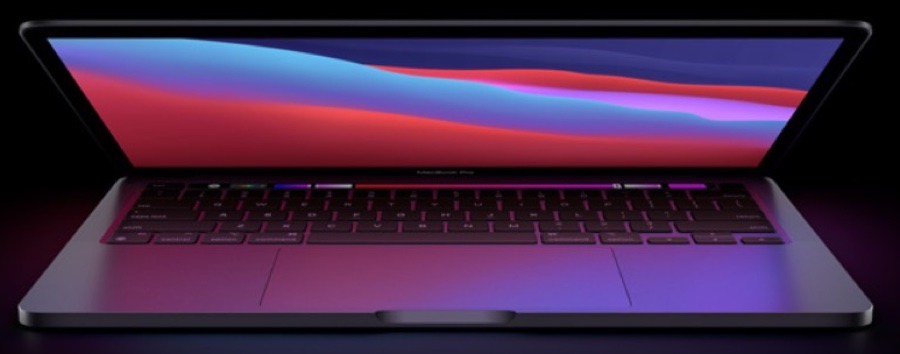
The duration is simply shocking, but it is also the part that – being locked up in the house – we were less aware. As well as the fan: the Mac also holds up well the efforts, both from the point of view of battery consumption and as regards the fans, which in a month we have simply never heard: they are there, they always “spin” a little, but they make absolutely no noise. Of course, they were also helped by the test season, because a colder environment helps dispersal. But believe it: you can “groped” the whole MacBook with your fingertips and there is nothing wrong with it.
We can't wait to be able to go outdoors again and travel with a MacBook equipped with this type of processor.
In conclusion, there is no reason not to take this computer or the MacBook Air which has substantially similar performance. The difference is given by the ability to sustain the effort of brute power longer and by an extra crumb of battery, as well as better ergonomics because the shell is thicker and appears firmer and more comfortable to write (at least, in the ' experience of this reporter, who has used MacBook Air and Pro for a decade). If you don't have specific needs, the Air is fine too. However, these are computers that completely change the cards on the table, bring down the value of second-hand Intel (alas) but at the same time bring an experience of computing that is essentially science fiction.
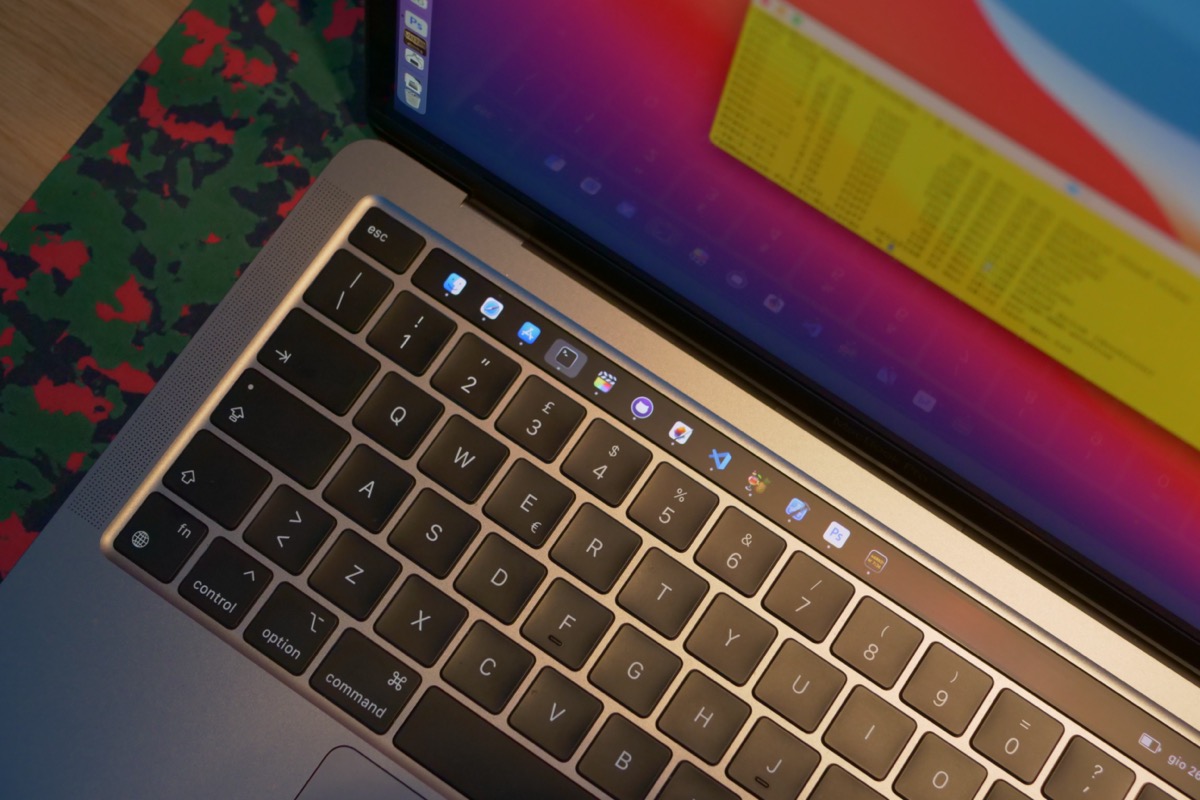
Pro:
• Infinite power, limitless memory, impressive • Unmatched smoothness of operation and enhanced camera • No more specs, just as good as an iPad Pro • Never heard the fan rattle • Battery lasts a life and a half, crazy
Versus:
• Many apps on iOS / iPadOS are not available or optimized • The two ports (left only) are inconvenient, just like in the Intel version • This is the first time we've written it, but this computer has practically no flaws!
Price and availability
Version tested: MacBook Pro 13 M1 16GB Ram, 1TB SSD. Price: 2,169 euros. In Italy it starts from 1,479 Euros including VAT for the 256GB SSD and 8 GB RAM model from this page of the Apple Store online. MacBook Pro 13 M1 is also available on Amazon at discounted prices with short-term super deals that you can discover by consulting our offers page.

